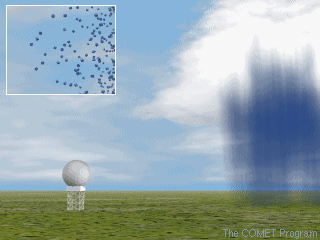 |
| FIG:Radar screen |
Radar is something that is in use all around us, although it is normally invisible. Air traffic control uses radar to track planes both on the ground and in the air, and also to guide planes in for smooth landings. Police use radar to detect the speed of passing motorists. NASA uses radar to map the Earth and other planets, to track satellites and space debris and to help with things like docking and maneuvering. The military uses it to detect the enemy and to guide weapons.
Meteorologists use radar to track storms, hurricanes and tornadoes. You even see a form of radar at many grocery stores when the doors open automatically! Obviously, radar is an extremely useful technology.
When people use radar, they are usually trying to accomplish one of three things:
Detect the presence of an object at a distance - Usually the "something" is moving, like an airplane, but radar can also be used to detect stationary objects buried underground. In some cases, radar can identify an object as well; for example, it can identify the type of aircraft it has detected.
Detect the speed of an object - This is the reason why police use radar.
Map something - The space shuttle and orbiting satellites use something called Synthetic Aperture Radar to create detailed topographic maps of the surface of planets and moons.
All three of these activities can be accomplished using two things you may be familiar with from everyday life: echo and Doppler shift. These two concepts are easy to understand in the realm of sound because your ears hear echo and Doppler shift every day. Radar makes use of the same techniques using radio waves
Exactly how does radar work?
As the radar antenna turns, it emits extremely short bursts of radio waves, called pulses. Each pulse lasts about 0.00000157 seconds (1.57x10-6), with a 0.00099843-second (998.43x10-6) "listening period" in between. The transmitted radio waves move through the atmosphere at about the speed of light.
By recording the direction in which the antenna was pointed, the direction of the target is known as well. Generally, the better the target is at reflecting radio waves (i.e., more raindrops, larger hailstones, etc.), the stronger the reflected radio waves, or echo, will be.
This information is observed within the approximately 0.001-second listening period with the process repeated up to 1,300 times per second. By keeping track of the time it takes the radio waves to leave the antenna, hit the target, and return to the antenna, the radar can calculate the distance to the target.
The WSR-88D's pulses have an average transmitted power of about 450,000 watts. By comparison, a typical home microwave oven will generate about 1000 watts of energy. However, because of the very short period the radar is actually transmitting, when the time of all pulses each hour are totaled (the time the radar is actually transmitting), the radar is "on" for a little over 7 seconds each hour. The remaining 59 minutes and 53 seconds are spent listening for any returned signals.
 | ||
| Animation shows how a radar detects the raindrop |

No comments:
Post a Comment
Thank you for your valuable suggestion. If you feel this post useful, please share our Blog with others!!! Comments just for Backlinking your Website or Blog will be Deleted...